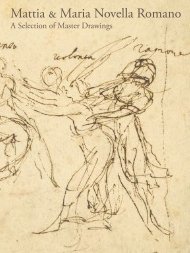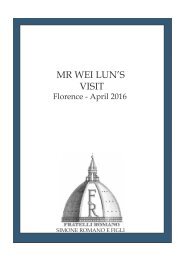A Selection of master drawings 2014
- No tags were found...
You also want an ePaper? Increase the reach of your titles
YUMPU automatically turns print PDFs into web optimized ePapers that Google loves.
15. Vincenzo Gemito<br />
Naples 1852 - 1929<br />
A Gypsy woman nursing her baby<br />
Charcoal on parchment<br />
287 x 170 mm. (11¼ x 6 ¾ in.)<br />
Inscriptions<br />
bottom left corner, in charcoal, Gemito 1900 Case [Co...]n.<br />
Vincenzo Gemito, the renowned Neapolitan sculptor, was<br />
an outstanding and prolific draughtsman. He was born in<br />
Naples in 1852 from an unknown 1 mother and left at the<br />
“ruota degli esposti” <strong>of</strong> the Annunziata church which served<br />
as an orphanage for abandoned infants. He was then adopted<br />
by a local woman, Giuseppina Baratta, and by Giuseppe<br />
Bes, a French artisan working in the service <strong>of</strong> the bourbon<br />
court. Vincenzo spent his adolescent years trying his hand<br />
at the most humble trades. As a young man with innate<br />
natural talent, very soon he was admitted into the workshop<br />
<strong>of</strong> the sculptor Emanuele Caggiano as an apprentice, where<br />
he became friends with the young painter Antonio Mancini.<br />
In 1864 his adoptive parents enrolled him at the Istituto di<br />
Belle Arti in Naples. Vincenzo had a boisterous character<br />
by nature and was not greatly inclined towards discipline.<br />
It is therefore unlikely that he attended the courses with the<br />
necessary diligence to gain much culture from them. However<br />
his genius and his desire to discover were certainly nourished<br />
by the artistic riches <strong>of</strong> his city; from the churches, which<br />
were indeed painting museums, mostly <strong>of</strong> the 1600’s, as well<br />
as the Archaeological Museum where he could practice from<br />
ancient examples. At the same time he also attended the<br />
studio <strong>of</strong> the sculptor Stanislao Lista, along with his friend<br />
Mancini, and dedicated his time to drawing nude models. As<br />
a result <strong>of</strong> this he received his first important commissions,<br />
the portrait busts <strong>of</strong> Domenico Morelli, Francesco Paolo<br />
Michetti and Giuseppe Verdi and his wife, to name just a<br />
few. This period was so favourable that Vincenzo managed<br />
to open a studio <strong>of</strong> his own in the Capodimonte district<br />
in 1876. The following year he moved to Paris, where he<br />
met Giovanni Boldini, 2 Paul Dubois, and through Mancini<br />
(with whom he shared his studio for some time) he also<br />
met the art dealer Goupil, who he pleaded with to help him<br />
gain the chance to participate at the Salon. 3 During this first<br />
stay in Paris (1877 - 1880), which was characterised both<br />
by his enthusiasm for the many requests he received from<br />
the city but also by sacrifices and economic difficulties, 4 one<br />
meeting proved to be fundamental for Gemito. That was<br />
his meeting with Jean Louis Ernest Meissonier, 5 who was at<br />
the time at the peak <strong>of</strong> his career. The portrait <strong>of</strong> the artist<br />
completed by Gemito in 1879 increased his notoriety. From<br />
that moment on he successfully participated in numerous<br />
International Exhibitions, both in Paris and in the rest <strong>of</strong><br />
Europe. He returned to Naples in 1880 and set up his own<br />
foundry. He had many prestigious commissions, the most<br />
notable <strong>of</strong> which was that from the King <strong>of</strong> Italy Umberto<br />
I, for a statue representing Carlo V, to be housed in one <strong>of</strong><br />
the niches in the Royal Palace in Naples. The work which<br />
had to be created in marble, a material not best suited to the<br />
artist, presented many problems in the course <strong>of</strong> its creation,<br />
enough in fact to push the artist to a nervous breakdown. 6<br />
Following this, as documented, he passed a difficult twenty<br />
years (1887 - 1909) in which the artist nevertheless earned<br />
great success thanks to the help <strong>of</strong> his many Neapolitan and<br />
Parisian admirers. In fact, we know that in 1900 Gemito<br />
participated in the Paris Universal Exhibition. There he<br />
exhibited The Water Carrier, the Portrait <strong>of</strong> Meissonier and<br />
a sketch <strong>of</strong> Charles V for which he won the Grand Prix.<br />
Again at the same event he presented a work in terracotta<br />
and seven bronzes representing studies <strong>of</strong> heads, a gypsy,<br />
a fisherman along with many <strong>drawings</strong> and watercolours. 7<br />
The work in question here, the Gypsy nursing her baby,<br />
signed and dated 1900, originates from this period. It is a<br />
study from life, which is intense, intimate and penetrating<br />
<strong>of</strong> this young gypsy woman who is absorbed in the moment<br />
nursing her child, which is carried with her in the traditional<br />
sling tied around her chest. Other <strong>drawings</strong> also show<br />
Gemito’s interest in gypsies, but this unpublished study<br />
is the only one executed on parchment. 8 This is a porous<br />
surface thanks to which the artist manages to achieve a sense<br />
<strong>of</strong> three-dimensionality. The words <strong>of</strong> Alberto Savinio come<br />
to mind when he wrote: «Gemito is more <strong>of</strong> a sculptor in<br />
his <strong>drawings</strong> than in his statues. In his <strong>drawings</strong> he starts<br />
with a point, from the beginning, from the intimate and<br />
spreads to infinity. His <strong>drawings</strong> continue beyond the page.<br />
Gemito dominates this medium with all the greatness <strong>of</strong> his<br />
soul, and with all the strength <strong>of</strong> his hands; he isolates it,<br />
reduces to the minimum necessary, no longer seeking lyrical<br />
perfection, but material perfection. Gemito’s statues are the<br />
pastimes <strong>of</strong> a demiurge.» 9





